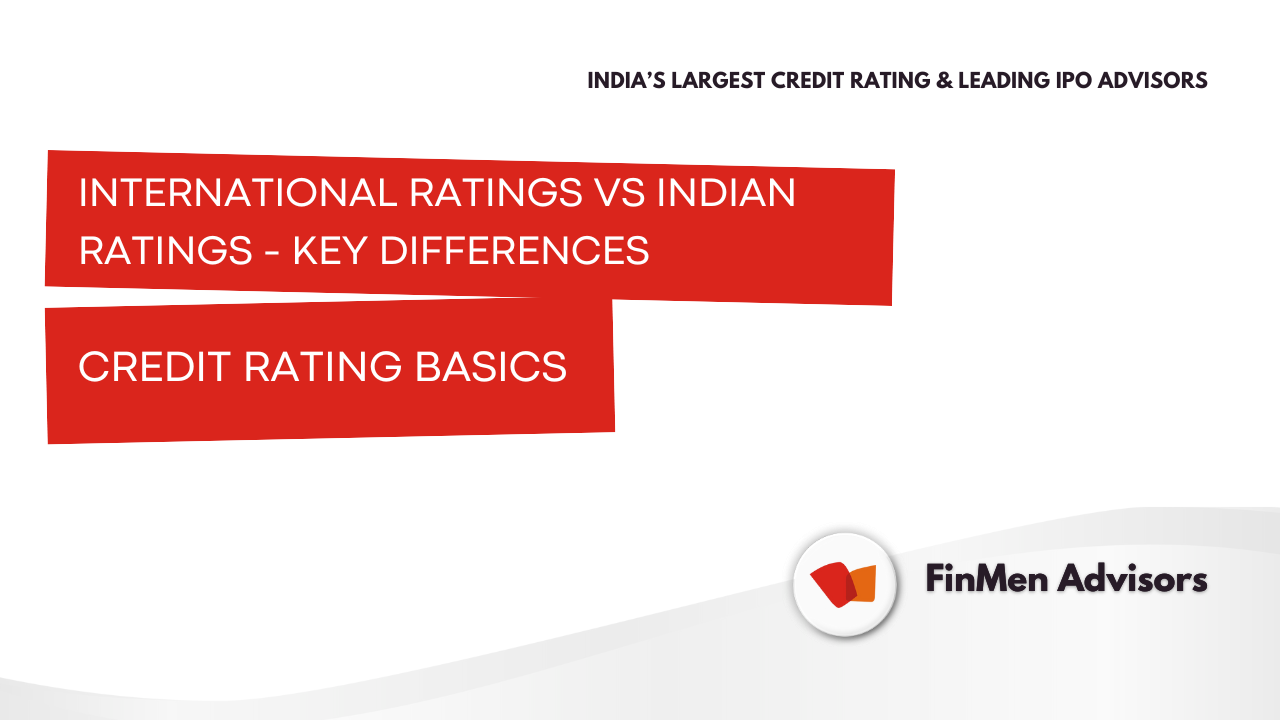Introduction
Credit ratings issued by global agencies such as Moody’s, S&P Global and Fitch and those issued by Indian agencies such as CRISIL, ICRA and CARE serve the same basic purpose — to communicate credit risk — but they differ in important ways: regulation, market scope, methodology emphasis, scale conventions, and how investors use them.
Understanding these differences helps CFOs, promoters and finance teams decide which rating(s) they need and how to present their business to credit raters.
FinMen Advisors, India’s Largest Credit Rating Advisory & Leading IPO Advisory firm, explains the key distinctions and practical implications for Indian businesses.
1. Regulatory & Oversight Differences
- Indian CRAs operate under SEBI’s CRA Regulations (1999) which set registration, disclosure and conduct standards.
- International CRAs are regulated by their home jurisdictions (SEC in the U.S., ESMA in Europe, etc.).
Implication: Indian agencies must comply with SEBI’s rules, while international agencies follow global frameworks.
2. Origins, Scale & Local Experience
- Indian CRAs like CRISIL were built for India’s domestic markets and have deep local expertise.
- Global CRAs grew with international capital markets and have broader cross-border databases.
Implication: For domestic markets, Indian CRAs bring stronger local insight; for global issuance, international CRAs add wider recognition.
3. Methodology Emphasis & Local Adjustments
- Both use quantitative (ratios, cash flows) and qualitative (management, governance) assessments.
- Indian CRAs adapt criteria to India’s accounting norms, regulatory environment and sector specifics.
Implication: The same company can receive different viewpoints from global vs local CRAs.
4. Scale Conventions & Notations
- Long-term symbols (AAA to D) are broadly similar.
- Short-term ratings (A1, A2, etc.) and modifiers (+/-) differ slightly.
Implication: Always check each CRA’s published definitions; don’t assume identical meaning.
5. Business Model & Market Perception
- Both global and Indian CRAs mostly use the issuer-pays model.
- Governance rules and rating committees ensure independence.
Implication: Transparency and disclosure are critical to balance potential conflicts of interest.
6. Currency & Sovereign Considerations
- International CRAs give separate local-currency and foreign-currency ratings, often capped by the sovereign rating.
- Indian CRAs mainly focus on rupee instruments and domestic funding.
Implication: For foreign-currency borrowing, international ratings are critical; for rupee debt, Indian ratings suffice.
7. Market Reach & Investor Base
- Global CRAs: Immediate recognition with international investors.
- Indian CRAs: Widely accepted by domestic banks, NBFCs and Indian investors.
Implication: Many issuers seek dual ratings for both domestic and international reach.
8. Transparency & Performance Reporting
- Both global and Indian CRAs publish methodologies, rating rationales and performance statistics.
- SEBI mandates periodic disclosures for Indian CRAs.
Implication: Companies should review each CRA’s criteria, not just the rating letter.
Practical Takeaways for Indian Companies
- Choose the rating agency based on your funding objective (domestic vs international).
- Dual ratings often provide the best of both worlds.
- Prepare for local nuances with Indian CRAs and global comparability with international CRAs.
- Keep updated with SEBI’s evolving rules for Indian ratings.
How FinMen Advisors Helps
At FinMen Advisors, India’s Largest Credit Rating Advisory & Leading IPO Advisory firm, we guide businesses in:
- Deciding whether to pursue Indian, international, or dual ratings.
- Preparing disclosures and presentations for rating committees.
- Positioning credit stories effectively for investors.
We don’t influence ratings — we ensure you’re fully prepared to present your strengths.
FAQs
Q1: Should an Indian company get both Indian and international ratings?
A1: For domestic fundraising, Indian ratings are usually enough. For foreign-currency borrowing or global investors, international ratings help.
Q2: Do international and Indian agencies use the same symbols?
A2: Broadly yes (AAA to D), but modifiers and short-term notations differ.
Q3: Are Indian CRA methodologies as rigorous as global ones?
A3: Yes. Indian CRAs tailor global frameworks to India’s unique market conditions, while international CRAs provide broader comparability.
Conclusion
Both international and Indian credit ratings are crucial tools — but they serve different audiences and purposes. Indian CRAs bring local expertise and are indispensable for rupee debt markets, while international CRAs provide global recognition for foreign investors.
As India’s Largest Credit Rating Advisory & Leading IPO Advisors, FinMen Advisors helps businesses understand these dynamics and prepare effectively for both domestic and international credit rating journeys.


